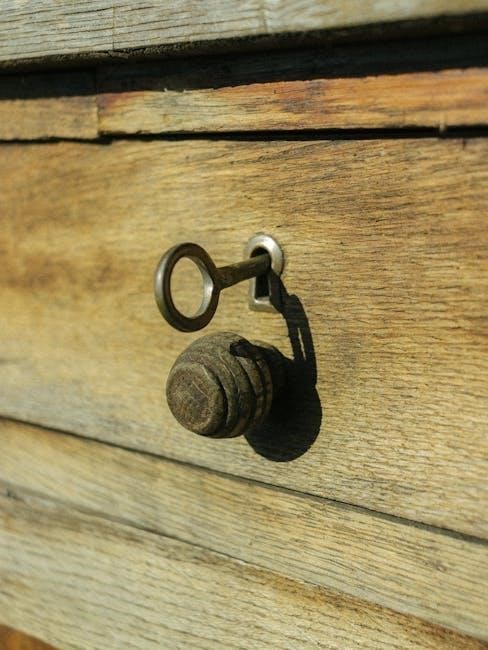ionic bonds worksheet answer key pdf
An ionic bond is a chemical bond formed through the transfer of electrons between atoms‚ resulting in the formation of positively and negatively charged ions. This fundamental concept is crucial in understanding chemistry‚ as it explains how ionic compounds form and interact. The ionic bonds worksheet answer key PDF provides detailed solutions and explanations‚ helping students master this essential topic.
1.1 Definition of Ionic Bonds
An ionic bond is a type of chemical bond formed when one or more electrons are transferred between atoms‚ typically from a metal to a non-metal. This transfer results in the formation of positively charged cations (metals) and negatively charged anions (non-metals). The electrostatic attraction between these oppositely charged ions holds them together‚ creating a strong and stable bond. Ionic bonds are essential for understanding the structure and properties of many compounds‚ especially salts. The ionic bonds worksheet answer key PDF provides clear examples and explanations to help students grasp this fundamental concept through practice problems and detailed solutions.
1.2 Importance of Ionic Bonds in Chemistry
Ionic bonds play a vital role in chemistry‚ as they are the primary bonding mechanism in the formation of salts and many minerals. These bonds are crucial for understanding the properties of ionic compounds‚ such as their high melting points and conductivity in molten or aqueous states. Ionic bonds also explain the formation of ions in solutions‚ which are essential for various chemical reactions and biological processes. The study of ionic bonds is fundamental for understanding periodic trends‚ chemical reactivity‚ and the behavior of matter. The ionic bonds worksheet answer key PDF helps students recognize the significance of ionic bonding through practical exercises‚ ensuring a solid foundation in chemistry concepts.

Components of an Ionic Bonds Worksheet
A typical ionic bonds worksheet includes sections for drawing atomic diagrams‚ writing chemical formulas‚ and naming compounds. It often features tables for electron transfers and reaction outcomes‚ along with practice problems to reinforce understanding. The answer key provides detailed solutions and explanations‚ ensuring students can review and correct their work effectively.
2.1 Structure and Layout
An ionic bonds worksheet typically follows a structured format to ensure clarity and effectiveness. It often begins with a section for drawing atomic diagrams‚ where students illustrate the valence electrons of reacting atoms. This is followed by a table or chart for documenting electron transfers‚ reactants‚ and resulting ionic compounds. Practice problems are included to test understanding of concepts like naming compounds and writing formulas. The layout may also feature separate areas for questions and answers‚ with visual guides like arrows to indicate electron movement. Some worksheets include a key at the end‚ providing correct answers and explanations to help students review their work. This organized structure helps students systematically grasp the principles of ionic bonding.
2.2 Common Exercises and Problems
Common exercises in an ionic bonds worksheet include writing chemical formulas‚ naming compounds‚ and identifying ions. Students often practice using the crisscross method to balance charges and determine formulas for compounds like NaCl or CaCO₃. Problems also involve identifying the type of bond (ionic or covalent) in a given compound. Another exercise is drawing electron transfer diagrams to show the formation of ions‚ such as the reaction between a metal and a nonmetal. Additionally‚ worksheets may include questions on polyatomic ions‚ requiring students to write correct formulas and names. These exercises help reinforce understanding of how ionic bonds form and how to apply basic chemistry principles to real-world problems. The answer key provides solutions to these exercises‚ ensuring students can verify their understanding and improve their skills.

Identifying Ionic Compounds
Ionic compounds are typically formed between metals and nonmetals‚ involving the transfer of electrons to create positively and negatively charged ions. These compounds often have high melting points and conduct electricity when dissolved in water‚ making them easily identifiable in a worksheet.
3.1 Characteristics of Ionic Compounds
Ionic compounds exhibit distinct physical and chemical properties. They are typically hard‚ brittle solids with high melting and boiling points due to the strong electrostatic forces between ions. Conductivity is another key feature—ionic compounds conduct electricity when dissolved in water or melted‚ as the ions become mobile. They often form crystalline structures‚ where positively charged cations are surrounded by negatively charged anions. These compounds are usually soluble in water and insoluble in organic solvents. Additionally‚ they tend to have neutral overall charges‚ balancing the charges of their constituent ions. These characteristics help in identifying and classifying ionic compounds in a worksheet setting.
3.2 Differentiating Ionic and Covalent Compounds
Differentiating between ionic and covalent compounds is crucial for understanding their bonding nature. Ionic compounds form between metals and nonmetals‚ involving the transfer of electrons and resulting in ions held together by electrostatic forces. They typically have high melting points‚ are hard‚ and conduct electricity when dissolved or melted. Covalent compounds‚ formed between nonmetals‚ involve sharing electrons‚ leading to molecules or networks. They usually have lower melting points‚ are softer‚ and are poor conductors. The ionic bonds worksheet answer key PDF helps students identify these differences through exercises and examples‚ ensuring a clear understanding of each compound type’s unique characteristics and properties. This distinction is vital for accurately naming and writing chemical formulas.

Writing Ionic Formulas
Writing ionic formulas involves using the Crisscross Method to balance charges between cations and anions. The ionic bonds worksheet answer key PDF provides examples and solutions to master this process.
4.1 Using the Crisscross Method
The Crisscross Method is a systematic approach to writing ionic formulas by balancing the charges of cations and anions. Start by writing the symbol of the cation (positive ion) and anion (negative ion). Cross the valence of the cation to the anion’s side and vice versa. This crossed number becomes the subscript for the respective ion in the formula. If the number is 1‚ it is omitted. For example‚ sodium (Na⁺) and chlorine (Cl⁻) form NaCl‚ while magnesium (Mg²⁺) and oxygen (O²⁻) form MgO. The ionic bonds worksheet answer key PDF provides numerous practice problems and solutions to master this technique.
4.2 Handling Polyatomic Ions
Polyatomic ions‚ such as carbonate (CO₃²⁻) and ammonium (NH₄⁺)‚ are groups of atoms that act as a single unit with a charge. When writing ionic formulas involving polyatomic ions‚ treat them as individual entities. Determine their charges and balance them with the charges of the cations. For example‚ calcium carbonate consists of Ca²⁺ and CO₃²⁻‚ combining to form CaCO₃. The Crisscross Method still applies‚ but the polyatomic ion’s charge must be considered as a whole. The ionic bonds worksheet answer key PDF includes exercises for compounds like ammonium phosphate and iron sulfate‚ ensuring students can handle these complex ions with confidence.

Naming Ionic Compounds
Naming ionic compounds involves identifying the cation and anion. The cation name comes first‚ followed by the anion‚ with “-ide” added to nonmetals. For transition metals‚ Roman numerals indicate charges. The answer key provides examples like ammonium chloride and iron (III) nitrate‚ ensuring accurate naming practices.
5.1 Basic Naming Rules
Naming ionic compounds follows a structured approach. The name of the cation (positive ion) is stated first‚ followed by the name of the anion (negative ion). For single-atom anions‚ the suffix “-ide” is added‚ such as in “chloride” from “chlorine.” When the cation is a transition metal with variable charges‚ a Roman numeral in parentheses indicates its charge‚ e.g.‚ “iron(III) oxide.” For polyatomic ions like “carbonate” (CO3^2-)‚ the entire group is treated as a single unit. The answer key provides examples and practice exercises to master these rules‚ ensuring clarity and consistency in naming ionic compounds accurately.
5.2 Naming Compounds with Transition Metals
Naming ionic compounds with transition metals requires specifying their charge using Roman numerals in parentheses. Transition metals often exhibit multiple valencies‚ so clarity is essential. The cation name is stated first‚ followed by the anion name with the “-ide” suffix. For example‚ “iron(III) nitrate” indicates iron in the +3 oxidation state. If a transition metal has a common name based on its lower charge‚ it may be used‚ such as “copper(I) oxide” for Cu₂O. The answer key provides practice exercises and examples‚ such as “titanium(III) bromide” and “copper(I) phosphide‚” to ensure mastery of these naming conventions for transition metal compounds.

Lewis Structures for Ionic Compounds
A Lewis structure for ionic compounds illustrates electron transfer between atoms‚ forming ions with complete valence shells. This visual tool helps students understand the bonding process and electron distribution.
6.1 Drawing Lewis Dot Diagrams
Drawing Lewis dot diagrams for ionic compounds involves representing valence electrons and their transfer between atoms. Start by identifying the valence electrons of each element. For metals‚ show valence electrons outside the atomic symbol‚ while nonmetals display all valence electrons in dots. Illustrate the transfer of electrons from the metal to the nonmetal‚ resulting in the formation of cations and anions. Use arrows to depict electron movement. Complete the diagrams by placing brackets around ions with their respective charges. This method helps visualize the ionic bond formation and electron distribution‚ making it easier to understand how ions combine to form neutral compounds. Practice worksheets provide exercises to master this skill‚ ensuring clarity in understanding ion formation and bonding.
6.2 Showcasing Electron Transfer
Showcasing electron transfer in ionic bonding involves visually representing how electrons move from one atom to another. Use arrows to indicate the direction of electron flow‚ ensuring the metal donates electrons to the nonmetal. After transfer‚ complete the Lewis diagrams by surrounding ions with brackets and their charges. For example‚ magnesium (Mg) loses two electrons to become Mg²⁺‚ while oxygen (O) gains two electrons to become O²⁻. This process highlights the formation of cations and anions‚ which attract each other to form ionic compounds. Worksheets often include such diagrams to help students understand and predict the outcomes of electron transfer in ionic bond formation. These visual representations are essential for mastering the concept of ionic bonding and compound formation.

Electron Transfer in Ionic Bonding
Electron transfer in ionic bonding occurs when metal atoms lose electrons to nonmetal atoms‚ forming a cation and an anion. This process results in the formation of ionic compounds.
7.1 Mechanism of Electron Transfer
In ionic bonding‚ electron transfer occurs when a metal atom loses one or more electrons to a nonmetal atom. This process creates a cation (positively charged ion) from the metal and an anion (negatively charged ion) from the nonmetal. The electrons transferred equalize the number of valence electrons‚ allowing both ions to achieve a stable electronic configuration. For example‚ sodium (Na) donates an electron to chlorine (Cl)‚ forming Na⁺ and Cl⁻ ions. These ions are attracted to each other due to their opposite charges‚ resulting in a strong ionic bond. This mechanism is fundamental to understanding how ionic compounds form and stabilize.
7.2 Resulting Ions and Compounds
When electron transfer occurs‚ the metal atom becomes a positively charged cation‚ while the nonmetal atom becomes a negatively charged anion. These ions are attracted to each other due to their opposite charges‚ forming a strong ionic bond. The resulting compound is neutral overall‚ as the number of positive and negative charges balances. For example‚ sodium (Na) and chlorine (Cl) form NaCl‚ where Na⁺ and Cl⁻ ions combine. The worksheet provides examples of such reactions‚ helping students identify the ions and compounds formed. Understanding this process is crucial for mastering ionic bonding and completing related exercises effectively.

Practice Problems and Solutions
The worksheet includes exercises like writing formulas‚ naming compounds‚ and identifying electron transfers. Example: Sodium and chlorine form NaCl. The answer key provides detailed solutions‚ ensuring understanding and accuracy in mastering ionic bonding concepts.
8.1 Example Reactions and Solutions
Example 1: Magnesium reacts with iodine to form magnesium iodide.
Reaction: Mg + I₂ → MgI₂
Solution: Magnesium loses two electrons‚ and each iodine atom gains one electron‚ resulting in Mg²⁺ and 2 I⁻ ions. The compound MgI₂ forms through electrostatic attraction.
Example 2: Aluminum reacts with chlorine to form aluminum chloride.
Reaction: 2 Al + 3 Cl₂ → 2 AlCl₃
Solution: Aluminum loses three electrons‚ and each chlorine atom gains one electron‚ forming Al³⁺ and Cl⁻ ions. The compound AlCl₃ results from the balance of charges.
These examples demonstrate how ions combine to form stable ionic compounds‚ with the answer key providing step-by-step explanations to ensure clarity and understanding.
8.2 Common Mistakes to Avoid
When working on an ionic bonds worksheet‚ students often make errors in electron transfer and ion formation. A common mistake is incorrectly calculating the charges of ions‚ leading to wrong chemical formulas. For example‚ confusing the charge of magnesium (Mg²⁺) with that of aluminum (Al³⁺) can result in incorrect compounds. Another error is forgetting to balance the charges when writing formulas‚ such as writing NaCl instead of Na₂O for sodium oxide. Additionally‚ students may mix up the crisscross method‚ especially when dealing with polyatomic ions. The answer key highlights these pitfalls‚ offering tips to avoid them and improve accuracy in solving ionic bonding problems.

Answer Key Features
The ionic bonds worksheet answer key provides detailed solutions‚ clear explanations‚ and helpful tips. It includes step-by-step walkthroughs for each problem‚ ensuring a thorough understanding of key concepts.
9.1 Detailed Solutions
The ionic bonds worksheet answer key offers comprehensive‚ step-by-step solutions for each problem. It provides clear explanations of how to determine the correct formulas‚ names‚ and electron configurations for ionic compounds. Each solution is broken down to ensure students understand the logic behind the answers. For example‚ when solving for the formula of a compound‚ the key demonstrates how to balance charges using the crisscross method. It also explains how to name compounds‚ including those with polyatomic ions and transition metals. The detailed solutions highlight common mistakes and offer tips to avoid them‚ reinforcing learning and preparation for exams.
9.2 Explanations and Tips
The ionic bonds worksheet answer key provides valuable explanations and tips to enhance understanding. It emphasizes recognizing metal-nonmetal combinations‚ ensuring correct charge balancing‚ and understanding polyatomic ions. Tips include using the crisscross method for formulas‚ identifying transition metals’ oxidation states‚ and avoiding common mistakes like incorrect naming of compounds. The key also advises students to practice drawing Lewis structures and electron transfer diagrams to reinforce concepts. By following these tips‚ students can improve their problem-solving skills and master ionic bonding fundamentals effectively.

Resources for Further Study
Recommended worksheets and reference materials offer in-depth practice and explanations. Utilize online guides‚ video tutorials‚ and PDF resources to reinforce concepts and explore advanced topics in ionic bonding.
10.1 Recommended Worksheets
For further practice‚ several recommended worksheets are available online. These include detailed PDF resources with exercises on writing ionic formulas‚ naming compounds‚ and drawing Lewis structures. Worksheets specifically designed for GCSE‚ IGCSE‚ and high school levels offer tailored exercises to match curriculum requirements. Many resources‚ like those from Teachers Pay Teachers‚ provide comprehensive answer keys and explanations. Additionally‚ some worksheets focus on electron transfer diagrams and distinguishing ionic from covalent compounds. These tools are ideal for reinforcing concepts and improving problem-solving skills. They are widely accessible and cater to various learning needs‚ making them invaluable for both students and educators seeking additional practice material.
10.2 Additional Reference Materials
Beyond worksheets‚ several additional reference materials are available to deepen understanding of ionic bonds. Detailed PDF guides and comprehensive answer keys provide step-by-step explanations for complex topics. Websites like Teachers Pay Teachers offer curated resources‚ including ionic bonding worksheets with solutions. Supplementary materials such as “Bonding Basics ‒ Ionic Bonds” and “Lewis Dot Ionic Bonding Worksheet” are highly recommended. These resources often include tips for mastering concepts like electron transfer and polyatomic ions; For visual learners‚ diagrams and atomic models are provided to illustrate bond formation. Many materials are designed for specific educational levels‚ ensuring relevance and effectiveness. These resources complement worksheets‚ offering a holistic approach to learning and reinforcing key concepts in ionic bonding.
Mastering ionic bonds is essential for understanding chemical interactions. This worksheet guide provides a clear path to grasping key concepts‚ ensuring confidence in identifying and forming ionic compounds. Keep practicing!
11.1 Summary of Key Concepts
11.2 Encouragement for Further Practice
Mastering ionic bonds requires consistent practice and a deep understanding of fundamental concepts. Encourage students to utilize the ionic bonds worksheet answer key PDF to self-assess their progress and identify areas for improvement. Regular practice helps reinforce key ideas‚ such as electron transfer‚ ion formation‚ and compound naming. Students should aim to apply these concepts to real-world examples‚ making their learning more engaging and meaningful. Don’t be discouraged by initial challenges—each problem solved brings greater confidence and proficiency. By dedicating time to practice‚ learners will develop a solid foundation in chemical bonding‚ paving the way for success in advanced chemistry topics. Keep practicing‚ and mastery will follow!
